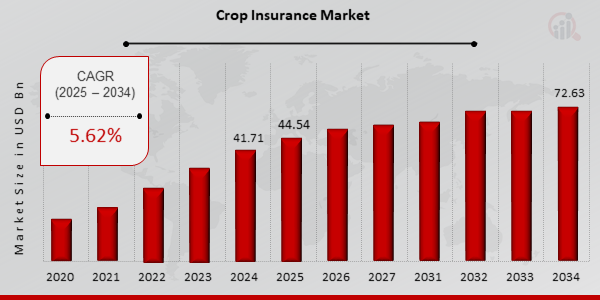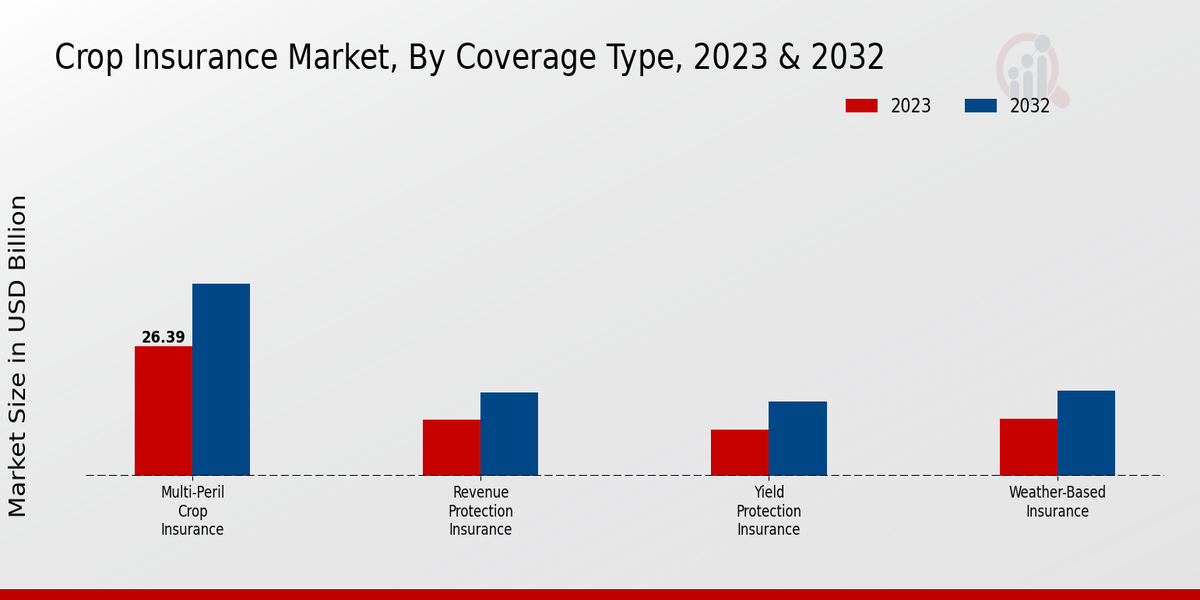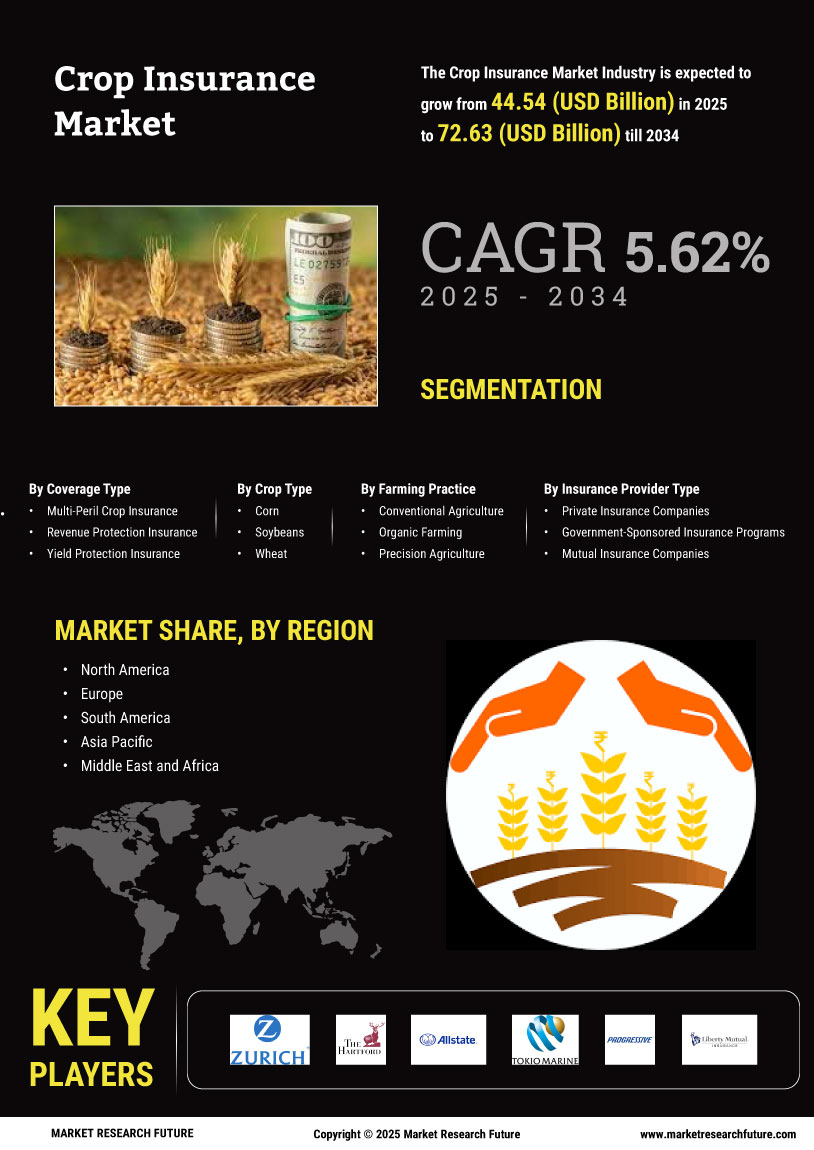Global Crop Insurance Market Overview:
Crop Insurance Market Size was estimated at 41.71 (USD Billion) in 2024. The Crop Insurance Market Industry is expected to grow from 44.54 (USD Billion) in 2025 to 72.63 (USD Billion) till 2034, exhibiting a compound annual growth rate (CAGR) of 5.62% during the forecast period (2025 - 2034)
Key Crop Insurance Market Trends Highlighted
Key market drivers include increasing awareness of crop insurance among farmers, rising frequency and severity of extreme weather events due to climate change, and government initiatives promoting crop insurance adoption. Opportunities exist in expanding coverage to new crops and regions, leveraging technology to enhance risk assessment and claims processing, and developing innovative insurance products tailored to specific farming practices. Recent trends include the growing adoption of parametric insurance, which provides payouts based on predetermined weather indices rather than actual crop loss, and the increasing use of drones and satellite imagery for crop monitoring and loss assessment. Additionally, there is a trend towards index-based insurance products, which link payouts to objective yield data rather than individual farm losses.

Source: Primary Research, Secondary Research, MRFR Database and Analyst Review
Crop Insurance Market Drivers
Increasing Awareness of Crop Insurance Benefits
A number of factors have led to the increased awareness and popularity of crop insurance among farmers and agricultural businesses. First, extreme weather events occur with greater frequency and increase in severity. Many agricultural regions have experienced severe droughts, floods, or hailstorms in recent years. Such events may cause substantial losses to the farmers and the agricultural businesses, which makes crop insurance appealing and valuable.Another significant factor is that many governments and agricultural organizations promote the adoption of crop insurance and provide grants or other incentives. These factors are likely to facilitate the increased implementation of crop insurance in the future.
Expansion of Crop Insurance Programs
Another crucially important driver of the Crop Insurance Market Industry is the increasing number of crop insurance programs. While this type of insurance tends to become more and more popular in the global arena today, governments all over the world have begun recognizing the great importance of this offer and creating new programs or expanding already existing ones. For instance, quite recently, the Indian government designed the Pradhan Mantri Fasal Bima Yojana, which is the world’s largest crop insurance scheme.It provides coverage against a wide array of risks, such as droughts, floods, or attacks of pests.
Technological Advancements
Technological advancements are playing a critical role in the growth of the Crop Insurance Market Industry. Remote sensing, drones and other similar technologies are becoming increasingly popular as they assist in assessing the risks by providing images and data. This method of assessment also assists in the easy processing of the claims. Crop insurance is becoming more affordable for farmers by reducing the cost. New insurance products like parametric insurance minimize the risks for farmers.
Crop Insurance Market Segment Insights:
Crop Insurance Market Coverage Type Insights
The Crop Insurance Market is divided by coverage type broadly into multi-peril crop insurance, revenue protection insurance, yield protection insurance, and weather-based insurance. Multi-peril crop insurance is the most inclusive type of insurance. It covers almost all types of risks that farmers and growers are facing. The multi-peril insurance will also protect the farmer from any risks associated with pest and disease infestation. Revenue protection insurance is there to protect the farmer’s revenue, no matter what the cause of the loss is.Similarly, yield protection insurance will protect the yield of the farmer, no matter what the cause of the yield loss. Weather-based insurance shields the farmer’s losses from harsh and severe weather. The multi-peril crop insurance type will have the largest share of the crop insurance market around the world in 2023. Simultaneously, revenue protection insurance will be growing at the fastest pace in the next few years. The growing features and demand of the revenue protection policy are driving its market, and growers are moving towards this policy, which provides them with more protection and flexibility.This will drive the growth of the Crop Insurance Market. There are many market drivers that are propelling the growth of this world market for crop insurance. These market drivers include a higher demand for food from the population around the world. Secondly, the expanding market for the agriculture industry itself is pacing the cost of production. The third and most important factor is the growing frequency and the harshness of the weather events. The Crop Insurance Market by value is anticipated to grow to USD 88.42 billion in 2032.

Source: Primary Research, Secondary Research, MRFR Database and Analyst Review
Crop Insurance Market Crop Type Insights
The Crop Type segment in the Crop Insurance Market is highly crucial. In 2023, the corn segment accounted for around 28.4% of the Crop Insurance Market revenue. The soybeans segment held around 22.1% of the market share that year. Wheat, rice, and cotton are other substantial crops. Meanwhile, there is increased interest in fruits and vegetables in this segment. The increasing buying of specialty crops from North America is also due to the expansion of such segments. The corn segment is expected to continue to dominate the Crop Insurance Market over the forecast period.By 2032, this segment will be worth USD 18.73 billion. Meanwhile, the soybeans segment is also expected to increase at a considerable pace, reaching a value of USD 14.52 billion that year. However, the wheat, rice, and cotton segments are expected to see slow growth as they are positively influenced by the government and technological developments. As for fruits and vegetables, they are expected to have the fastest growth rate during the forecast period. Their CAGR will amount to 5.2%, with the reason for the growth being the increase in the consumption of such goods.
Crop Insurance Market Farming Practice Insights
The Farming Practice segment plays a crucial role in the Crop Insurance Market. Conventional Agriculture, Organic Farming, and Precision Agriculture are the key sub-segments within this segment. Conventional Agriculture, with its large-scale farming techniques, is projected to hold a significant share of the market in the coming years. Organic Farming, driven by rising consumer demand for sustainable products, is expected to witness a steady growth rate. Precision Agriculture, utilizing technology for data-driven farming, is anticipated to emerge as a promising sub-segment, offering the potential for improved crop yields and reduced environmental impact.The Crop Insurance Market revenue generated from the Farming Practice segment is expected to grow at a notable CAGR during the forecast period, driven by increasing awareness about crop insurance, government initiatives, and technological advancements.
Crop Insurance Market Insurance Provider Type Insights
The Crop Insurance Market is segmented by Insurance Provider Type into Private Insurance Companies, Government-Sponsored Insurance Programs, and Mutual Insurance Companies. Private Insurance Companies held the largest market share in 2023, accounting for over 60% of the Crop Insurance Market revenue. This dominance is attributed to the expanding product portfolio and strategic partnerships with agricultural businesses. Government-Sponsored Insurance Programs are expected to witness substantial growth during the forecast period, owing to government initiatives and subsidies aimed at promoting crop insurance adoption among farmers.Mutual Insurance Companies are anticipated to gain traction due to their focus on providing tailored insurance solutions to meet the specific needs of farmers.
Crop Insurance Market Regional Insights
The Crop Insurance Market is segmented into North America, Europe, APAC, South America, and MEA. Among these regions, North America is expected to hold the largest market share in 2023 and is projected to continue its dominance throughout the forecast period. The region's large agricultural industry, coupled with government support for crop insurance programs, is driving market growth. Europe is another major market for crop insurance, with a significant demand for crop protection due to the region's reliance on agriculture. APAC is expected to witness the highest growth rate during the forecast period, owing to increasing awareness about crop insurance and government initiatives to promote agricultural productivity.South America and MEA are also expected to contribute to the growth of the Crop Insurance Market, as these regions have a large agricultural sector and are increasingly adopting crop insurance to mitigate risks associated with adverse weather conditions and other agricultural challenges.

Source: Primary Research, Secondary Research, MRFR Database and Analyst Review
Crop Insurance Market Key Players And Competitive Insights:
Major players in the Crop Insurance Market industry are constantly innovating and developing new products and services to meet the changing needs of farmers. Leading Crop Insurance Market players are also investing heavily in research and development to improve the efficiency and accuracy of their products. The Crop Insurance Market industry is expected to witness significant growth in the coming years, driven by the increasing demand for food security and the growing adoption of precision farming techniques.A leading company in the Crop Insurance Market is Zurich Insurance Group. The company offers a wide range of crop insurance products and services, including crop hail insurance, crop revenue insurance, and crop yield insurance. Zurich Insurance Group has a strong global presence and a deep understanding of the agricultural industry. The company is committed to providing farmers with the best possible protection against crop losses.A competitor company in the Crop Insurance Market is Munich Re. The company offers a similar range of crop insurance products and services as Zurich Insurance Group. Munich Re has a strong global presence and a long history of providing insurance to farmers. The company is known for its expertise in risk management and its ability to develop innovative insurance products.
Key Companies in the Crop Insurance Market Include:
-
Zurich Insurance Group
-
The Hartford
-
FCIS (Federal Crop Insurance Corporation)
-
Allstate Insurance Company
-
Tokio Marine Holdings, Inc.
-
Progressive Corporation
-
Liberty Mutual Insurance Group
-
The Hanover Insurance Group
-
munich re
-
Society Insurance
-
Chubb
-
Nationwide Insurance
-
The American P C Insurance Group
-
Farmers Mutual Hail Insurance
-
American Farm Bureau Federation
Crop Insurance Industry Developments
The Crop Insurance Market is projected to reach USD 88.42 billion by 2032, exhibiting a CAGR of 4.63% during the forecast period (2024-2032). Increasing government initiatives and subsidies to promote crop insurance adoption, rising awareness among farmers about the benefits of crop insurance, and the growing adoption of technology in the agriculture sector are driving market growth.Recent developments in the market include the launch of new crop insurance products tailored to specific crops and regions, collaborations between insurance companies and agricultural technology providers to offer integrated solutions, and the use of artificial intelligence (AI) and remote sensing technologies to improve risk assessment and claims processing.
Crop Insurance Market Segmentation Insights
Crop Insurance Market Coverage Type Outlook
-
Multi-Peril Crop Insurance
-
Revenue Protection Insurance
-
Yield Protection Insurance
-
Weather-Based Insurance
Crop Insurance Market Crop Type Outlook
-
Corn
-
Soybeans
-
Wheat
-
Rice
-
Cotton
-
Fruits
-
Vegetables
Crop Insurance Market Farming Practice Outlook
-
Conventional Agriculture
-
Organic Farming
-
Precision Agriculture
Crop Insurance Market Insurance Provider Type Outlook
-
Private Insurance Companies
-
Government-Sponsored Insurance Programs
-
Mutual Insurance Companies
Crop Insurance Market Regional Outlook
-
North America
-
Europe
-
South America
-
Asia Pacific
-
Middle East and Africa
|
Report Attribute/Metric
|
Details
|
|
Market Size 2024
|
USD 41.71 Billion
|
|
Market Size 2025
|
USD 44.54 Billion
|
|
Market Size 2034
|
USD 72.63 Billion
|
|
Compound Annual Growth Rate (CAGR)
|
5.62% (2025-2034)
|
|
Base Year
|
2024
|
|
Market Forecast Period
|
2025-2034
|
|
Historical Data
|
2020-2023
|
| Market Forecast Units |
USD Billion |
|
Report Coverage
|
Revenue Forecast, Competitive Landscape, Growth Factors, and Trends
|
| Key Companies Profiled |
Zurich Insurance Group, The Hartford, FCIS (Federal Crop Insurance Corporation), Allstate Insurance Company, Tokio Marine Holdings, Inc., Progressive Corporation, Liberty Mutual Insurance Group, The Hanover Insurance Group, munich re, Society Insurance, Chubb, Nationwide Insurance, The American P C Insurance Group, Farmers Mutual Hail Insurance, American Farm Bureau Federation |
| Segments Covered |
Coverage Type, Crop Type, Farming Practice, Insurance Provider Type, Regional |
| Key Market Opportunities |
Data analytics and AI Leverage AI and data analytics to enhance risk assessment and underwriting processesExpansion to emerging markets Target high-growth regions with untapped potential for crop insurance coverageDigitization and automation Streamline processes and improve efficiency through digitization and automationClimate change adaptation Align products and services with the growing need for climate-resilient solutionsPartnerships and acquisitions Collaborations and strategic acquisitions to gain market share and expand product offerings |
| Key Market Dynamics |
Key Market DynamicsGovernment initiativesRising crop lossesTechnological advancementsClimate change impactIncreasing demand for organic farming |
| Countries Covered |
North America, Europe, APAC, South America, MEA |
Frequently Asked Questions (FAQ) :
The Crop Insurance Market was valued at approximately USD 41.71 billion in 2024 and is projected to grow at a CAGR of 5.62% from 2025 to 2034, reaching a market size of around USD 72.63 billion by 2034.
North America is expected to dominate the Crop Insurance Market over the forecast period, owing to the presence of a well-established agriculture sector and government support for crop insurance programs.
Key growth drivers of the Crop Insurance Market include increasing demand for food security, rising awareness of crop insurance benefits, and government initiatives to promote crop insurance adoption among farmers.
The multi-peril crop insurance segment is expected to hold the largest share in the Crop Insurance Market due to its comprehensive coverage against various risks and uncertainties faced by farmers.
Some of the key players operating in the Crop Insurance Market include Allianz, AXA, Chubb, The Hartford, and Zurich Insurance Group.
Emerging trends in the Crop Insurance Market include the use of precision agriculture technologies, the development of parametric insurance products, and the adoption of index-based insurance schemes.
Climate change is expected to have a significant impact on the Crop Insurance Market, as it is likely to increase the frequency and severity of weather-related events, leading to higher crop losses and increased demand for crop insurance.
Challenges faced by the Crop Insurance Market include low insurance penetration rates in developing countries, lack of awareness among farmers, and regulatory complexities.
Technology is expected to transform the Crop Insurance Market by enabling the development of innovative insurance products, improving risk assessment and underwriting processes, and enhancing customer service.
The outlook for the Crop Insurance Market over the next five years is positive, with increasing demand for food security, rising awareness of crop insurance benefits, and government support expected to drive growth.

















